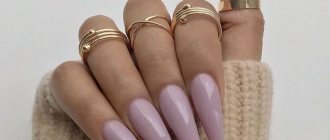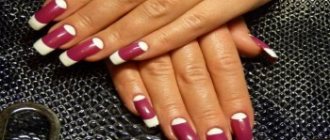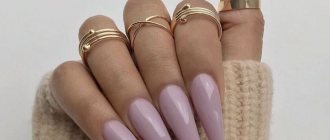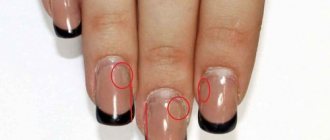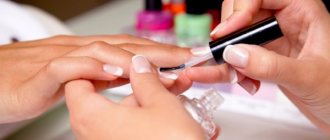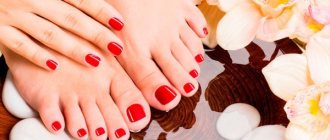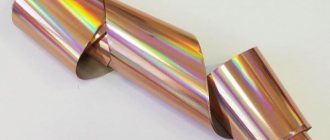Owners of beautiful and durable nails of the correct oblong shape can afford not to think about the question of what tips are and what they are needed for. However, the vast majority of girls cannot boast of this. Poor environmental situation, poor nutrition and harmful emissions into the atmosphere, constant lack of sleep and total fatigue syndrome, all this directly affects the overall health, therefore, hair, skin and nails too. Everyone needs to strive for the right lifestyle and try to follow the regime, but this does not guarantee that in the end you will be able to grow the manicure you would like. That is why you should understand what tips are and how they can be useful in creating a fashionable image.
What are tips?
This is the name given to plastic overlays that imitate nail plates. They are used as a substrate or stencil to obtain an artificial nail plate of the desired shape and length. Such templates are made from thin and elastic plastic. They come in transparent and colored: ivory, white, beige, ready-painted and in other options.
White overlays are ideal for creating a French manicure. They already have a ready-made smile line. After gluing such tips, it is enough to give them the desired shape, apply a thin layer of gel or acrylic to the nails and use a top coat to add shine.
Basic set of materials
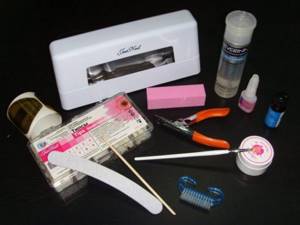
In addition to the templates themselves, you will need:
- glue for extensions
- length cutter
- sawing machine
- UV or LED lamp
- file and buff
- pusher
- tassel
- lint-free wipes
- material to choose from: gel, biogel, acrylic, acrylic in base and camouflage shades
- degreaser/dehydrator
- acidic or acid-free primer
- base
- top or finish to add shine
- varnish and decor as desired.
The principle of nail extension with tips
The tip is attached to the nail plate using special glue and becomes its extension. For a reliable connection with the nail along the smile line, the tips have a convenient transition zone. The contact area of the plastic blank is glued to the nail plate, and the rest of it lengthens the nail.
After gluing, the tips are trimmed and filed depending on the desired size and shape of the nails, and then covered with acrylic or gel. The camouflage material creates a nail plate that is visually similar to the natural one.
These overlays are quite easy to use, so even beginners can handle the procedure of nail extension with tips. The main thing is to choose the right pads according to the width of each nail and strictly follow the instructions. Experienced craftsmen do not neglect such materials, especially if they need to simplify and speed up the extension procedure.
Acrylic
Acrylic is a durable, quick-drying material. Acrylic nails are elastic; after extensions, the nails turn out thin and look natural. When using acrylic at home, you need to choose a well-ventilated room, as the substance has a specific aroma.
Extension tools
Before you move on to creating an artificial nail using tips, you should check if you have all the tools at hand.
List of materials:
- extension material – acrylic;
- primer or degreaser;
- liquid for dissolving acrylic - monomer, volume of at least 50 ml;
- set of tips;
- brush for applying acrylic powder;
- nippers for cutting tips;
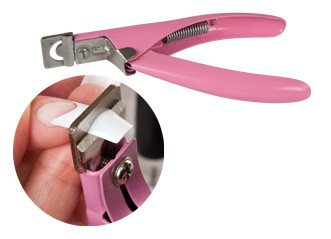
- file with abrasiveness from 100 to 180 grit;
- lint-free wipes;
- buff;
- alcohol or other disinfectant;
- a jar with a lid will be needed for the monomer;
- dust removal brush;
- glue for tips;
- oil or cuticle softener.
After purchasing all the necessary materials, you can start creating beautiful nails.
Instructions
Before you start doing any manicure, you should wash your hands well with antibacterial soap. If this is not possible, then the skin of the hands is treated with a disinfectant, alcohol or antiseptic.
Extension process:
- File the free edge of the natural nail.
- Remove cuticles using an orange stick.
- Use a nail file to remove oily shine from nails.
- Choose the right tip for each nail; the contact area should cover less than half of the nail plate.
- The numbering of tips starts with the number 1 and ends with the number 10, the first size is the widest, then the width decreases.
- Arrange the tips after selection in order.
- File down the edge of the contact area on each frame.
- Degrease the nail plate.
- Apply glue to the contact area and distribute it evenly.
- The tips should be held at an angle of 45 degrees to prevent the glue from spreading.
- Apply the tip so that the stop line is in contact with the tip of the natural nail.
- Press the frame onto the nail plate and hold until it holds firmly.
- Adjust the length of the free edge using a cutter.
- Using a file, give the frame the desired shape.
- Use a buff to reduce the boundary between the tip and the natural nail, so that when you run your finger along the plate you don’t feel the bumps.
- Mix acrylic powder with monomer until a plastic mass is obtained.
- Using a brush, evenly distribute the acrylic mass along the entire length of the nail.
- You can remove excess thickness with a nail file.
- Apply a fixative to the nail.
After the fixative has completely dried, the nails can be covered with a single-color varnish or a special design can be created. For beginners, it is better to use colorless acrylic for nail extensions with tips, and a light pink color is suitable for French manicure. Extending nails with tips using acrylic is a very easy and simple procedure.
Recommendations for selection
To obtain a neat manicure, it is important that the tips accurately follow the shape of the nail rims. Therefore, they are selected individually - strictly according to the width of the nail plate in the central zone, so that the template completely follows the anatomical shape and outline of the nail. In addition to the classically shaped tips, you can choose the following models:
- with a wide, narrow or short contact area;
- tapered;
- dihedral;
- with a pronounced transverse curve;
- made in other versions.
Tips of non-standard shape are used to lengthen convex and flat nails. If the plate has an uneven wavy surface, adhesive gel is perfect for attaching tips to it. It will easily fill uneven areas and create an intermediate layer for securely fastening the overlay.
What is needed for nail extensions with tips?
To complete this procedure you will need:
- chlorhexidine or other antiseptic;
- cuticle remover;
- an orange stick or pusher to push away the leathery roller;
- nail scissors to trim nails to 0.5–3 mm;
- file 100/180 grit;
- polishing block (buff) or file up to 240 grit - to remove the glossy layer from the nail plates;
- brushes for removing dust after filing;
- brushes for applying the products used;
- degreaser;
- tips of different sizes - choose thin and elastic plates of a shape that suits you;
- glue for fixing plastic linings;
- lint-free wipes;
- type cutter - to give plastic plates the required dimensions;
- primer – acid-free for gel extensions and acidic for acrylic;
- for gel extensions – modeling gel and UV lamp;
- sticky layer remover;
- for acrylic technology – acrylic powder and monomer (liquid);
- cuticle oil.
Consumables and tools
| Consumables | Tools |
| GelAcrylic Primer Degreaser for the nail plate. Napkins Upper forms – set. Antiseptic Cuticle oil | Gel brushes Buff and brushes Wire cutters Files orange stick ultraviolet lamp |
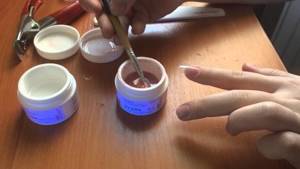
Preparation for the procedure
Before you extend your nails with tips at home, you need to prepare for this procedure. If you prefer a cut manicure, remove the cuticles at least 4 days before extensions. For 12 hours before the scheduled procedure, do not use hand cream, and in the last 3 hours, avoid prolonged contact with water. These measures contribute to strong fixation of the material.
Before the procedure itself you need:
- Prepare a workplace, materials and tools. Disinfect them, and also treat your hands and work surfaces with an antiseptic.
- Prepare the tips and arrange them in the order of gluing to simplify further work. The length of the overlays should not exceed 2/3 of the length of your own nail. The width of the tips must exactly match the nail plates in the central part and completely coincide with them, from corner to corner. Narrower pads are not suitable for use, but wider ones can be carefully trimmed and filed to the desired size.
- Treat the cuticle - soften it using a remover and carefully push it away with an orange stick or pusher.
- Cut off the overgrown part of the nails to 0.5–3 mm and give them a neat shape with a file.
- Remove the fat layer from the plates (visually a shiny surface). This layer is restored in 40 minutes, so it must be removed immediately before the extension procedure. To do this, use a polishing block (buff) or a file up to 240 grit. The glossy layer is removed by movements from the cuticle to the edge of the plate. The resulting dust is removed with a brush.
After preparatory operations, a primer-degreaser is applied to the nails. Its effect lasts half an hour, so after degreasing, you need to immediately start building up. Otherwise, the fat layer will be restored, and the fixation of the tips will not be strong enough.
How to glue tips on nails?
The glue is applied to that part of the artificial plate that is in direct contact with the nail. It must be applied in a continuous layer over the entire surface of the hole, but only at the point where the tip will join the nail - up to the step line, which will coincide with the edge of the nail.
Apply the tip coated with glue to the middle of the nail at an angle of 45° and press the remaining part of the workpiece so that the smile line coincides with the edge of the nail. Press the plate gently to avoid the formation of bubbles. Otherwise, the tips will have to be re-glued to get a flawlessly beautiful manicure. To ensure the pad adheres well, press it for 10–15 seconds. Remove excess glue with a lint-free cloth.
Adhesive mixture
It is especially important to choose glue for tips. It usually comes in a kit with these parts. If it is not there or it has run out, craftsmen recommend buying the adhesive composition in a specialized store. Adhesives not intended for this purpose (“Second”, “Superglue”) will cause harm to health.
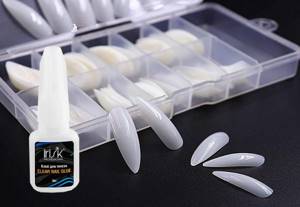
The most common glue is Irisk. It has high adhesion strength and comes straight with a brush for application.
Length correction and shape creation
At the next stage, the glued tips need to be given the desired shape. To do this, use a tip cutter and an abrasive file, no more than 100 grit. The tip cutter makes it easy to remove excess length and give the overlays any shape, and the file removes small irregularities and smoothes the transition from nail to tip. The joint must be thoroughly cleaned so that the transition is not noticeable and the surface of the workpiece becomes smooth and stepless.
It is also necessary to clean the surfaces of the plates with a buff or file to ensure effective adhesion to the gel or other coating. Before applying it, all that remains is to remove the accumulated dust from the nails and skin, treat the nail plates with a degreaser and apply a primer.
Advantages and disadvantages
Advantages:
- rapid increase in length;
- less chance of allergies;
- ease of extension, which even a beginner in nail art can easily handle;
- you can make smooth nails, even on deformed nail plates;
- You can create an exclusive nail design of maximum length and various shapes.
Flaws:
- it is difficult to achieve a natural look;
- in the first stages, large expenditures of money are required;
- Due to the thick free edge, artificial nails are inconvenient to use.
Nail extension with tips and gel
Working with the gel includes the following steps:
- Apply 1 layer thinly, retreating about 1 mm from the cuticle.
- Drying in a UV lamp for 2–3 minutes.
- Apply 2 layers - in the middle of the nail, in a denser layer with a gradual decrease in its thickness towards the sides.
- Dry in a UV lamp for at least 3 minutes. In case of discomfort due to heating of the nail, it is permissible to take a short break. In this case, it is important to turn the nail down so that the not yet hardened gel layer does not spread. After drying, you need to remove the sticky layer with a product designed for this purpose.
- Filing – performed after applying the main gel coating to all nails. All irregularities in the arch are removed with a file or buff, and the final shape is given to the nails. The edges are filed until they are thin so that they look natural. The sides and area near the cuticle are thoroughly cleaned. At the same time, it is important to minimize the coating to the maximum, give it a natural look and bring it to perfection. The resulting dust is removed with a brush.
- Applying 3 layers – gel finishing coat. It is applied as thinly and evenly as possible to the entire plate, including the previously untouched area near the leathery ridges.
- Drying in a UV lamp and removing the sticky layer (if any). When using a topcoat without a sticky layer, there is no need to remove it.
- Grinding of extended nails.
- Cuticle care - applying nourishing oil.
- Applying a topcoat or finishing decoration - varnish, modeling, artistic design or other method.
Nail extension with tips and acrylic
If acrylic is used instead of gel, there is no need for a UV lamp. But this extension method is not suitable for allergy sufferers, people with diabetes, herpes, fungal diseases or weak immunity. Acrylic extension technology involves the use of monomer and acrylic powder.
Gluing tips, correcting their length and shape, sanding and degreasing are carried out in the same way regardless of the chosen material. But the further steps for acrylic extensions are different:
- An acrylic brush is dipped into monomer and then into translucent or pink acrylic powder.
- The resulting ball is placed in the center of the nail plate and distributed over the surface. This needs to be done quickly, because... acrylic hardens in a few seconds.
- The resulting coating is filed down. The arch is given a beautiful bend. The polishing block removes all irregularities and achieves a glossy surface.
The procedure is completed in the same way as with gel extensions - by applying oil to the cuticle and finishing decoration.
Common mistakes when using tips
The first mistake common among beginners is the wrong choice of tips. The sets come with overlays of different sizes, and you need to choose them individually for each nail. If there is no tip of the ideal width, you can take a slightly wider tip and first file it to the desired size.
The second mistake beginners make when preparing the nail plate is when they file it down heavily when removing the glossy layer. The surface of the nail must be sanded delicately without damaging it. You need to carefully remove the shiny layer with a buff or file, using light movements from the cuticle to the open edge.
Another common mistake is choosing the wrong glue. The quality of fastening the tips and the durability of the manicure depend on it. But this does not mean that you need to choose glue with maximum fixation. To avoid damaging your nails, it is better to use glue with moderate fixation. This rule is especially true for thin nails.
You need to glue the tips slowly to avoid the formation of air bubbles in the joint area. They not only look unsightly, but also contribute to the development of infection and cause tips to quickly fall off. Therefore, the presence of bubbles is considered a gross defect and a signal that the nail needs to be redone.
Types of tips and which ones to choose
Types of tips are divided into several categories:
- By appointment. It all depends on what kind of manicure you are going to do. For example, for a classic French style, thicker tips are chosen; for building up and covering the plates with colored gel, transparent tips are chosen; if you are going to decorate the tips only with a design, you choose colored ones or use ready-made solutions that just need to be covered with clear varnish.
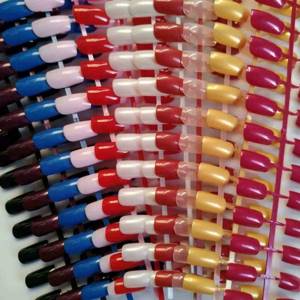
- According to the form. The difference in tip shape is important, and the choice depends on your preferences and the individual characteristics of natural marigolds. The classic version of tips is most similar in appearance to natural nails. Other tips for modeling nail plates are non-contact, tapered, “American” and for almond-shaped nails.
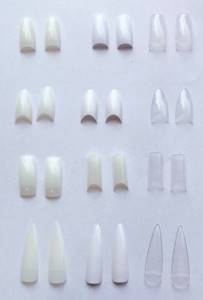
Tips of different shapes
- By color. The color range of products is very wide. There are transparent options, nude, colored - matte, glossy, with a pattern, with a design, French tips to create a smile.
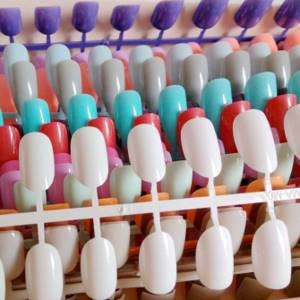
Multi-colored tips for extensions
- Based on manufacturing materials. In production, when producing tips, three materials are usually used. These are polyflex, ABS plastic and nylon.
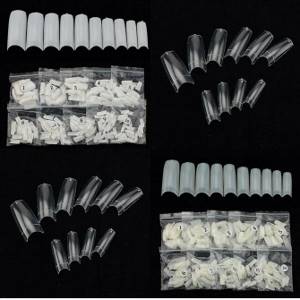
When choosing and purchasing tips, pay attention to the following points and details:
- Products must be intact, without nicks, chips, rough surfaces or scratches.
- Consider what shape and thickness the blanks should be so that the design on artificial nails looks natural.
- Choose high-quality tips so that they are strong. Even though the purchase will cost you a little more, the item will be much more reliable.
- When choosing template sizes, try to guess the size. It’s okay if they are a little larger than the nail, so the shape will fit better on the manicure.
- If you are going to do your own manicure with tips all the time, buy sets that will definitely have templates that are ideal for you.
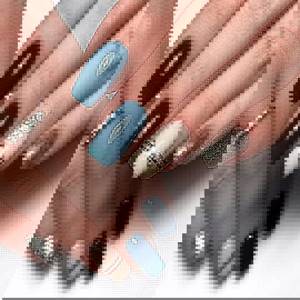
@rimma.nails.vbg
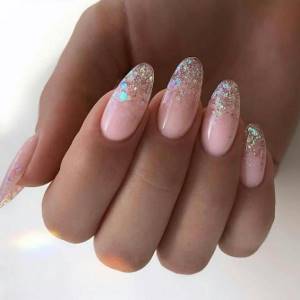
@tvoy_maniikur

The most common types of tips:
Tips-tips
These are disposable products that are attached to the edge of a natural nail using a special glue that comes with them.
Most often, one set of such templates includes products of different sizes, so that you can choose the shape individually for your manicure.
The technology of extensions using tip tips is very simple, the template does not reach the cuticle area, so you do not have to struggle with glue for a long time, trying to adapt the tips to the cuticle.

Tips for extensions
Upper forms
These are special reusable forms of different sizes. The material is laid out inside the product, pressed against the nail, under the cuticle, and dried in a lamp. Holding the tips of the plates, the tips are removed and the nails are given the correct shape with a file.

Liquid tips
These forms are also reusable, but unlike the upper forms, here you give the future nails an outline, a base layer. Then, after drying in a lamp, the liquid tip is removed and the nail is laid out in layers of gel, drying each layer.

Classic tips
These are disposable products on which glue is applied. It is easiest to grow your nails with classic tips; this action does not require you to have any specific skills in nail design. You just need to select the tips of the correct shape, apply glue and firmly fix the shape on the nails. The excess length is cut off with a regular nail file. To apply the glue, use the brush that comes with the kit.

Nail care using tips
After extension with tips, nails retain their acquired length and attractive appearance for a long time. The main thing is to follow simple rules:
- Make corrections monthly.
- Avoid impacts and mechanical damage, including when using pins, buttons, fasteners and other everyday accessories.
- When cleaning, washing dishes and performing similar work, protect your hands with rubber gloves.
- Avoid contact with hot water and hot air.
- Use delicate files with fine abrasive.
- Before a manicure, always apply a base coat.
- Use varnishes and other products without acetone.
- Remove growing cuticles with oil or special emollients.
After wearing tips, nail plates require intensive nutrition and hydration. To do this, you need to apply cuticle oil to them 2-3 times a week and polish them once every 10 days.
Care Tips
To ensure that your manicure pleases you and those around you for as long as possible, follow these tips:
- Regularly apply cream to the skin of your hands, thoroughly rubbing it into the cuticle area.
- Always use gloves when handling household chemicals.
- Avoid steaming your palms too often.
- During the cold season, do not go outside without gloves.
- Do not hit your nails on hard surfaces or try to pick anything out with them.
These are the basic tips for caring for extended manicure, which every self-respecting girl should adhere to.
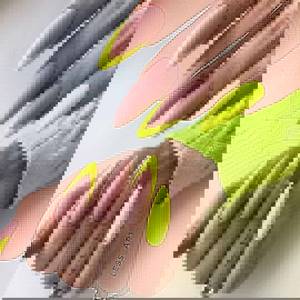
@seeyour.nails
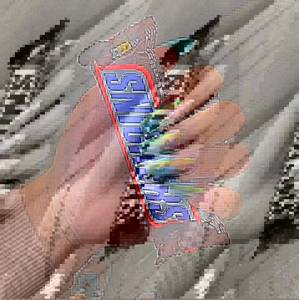
@nails_sanam

@nails_rokcsi
Why not try it?
Nail extension with tips is a fairly simple technology that is great for beginners to practice and allows you to lengthen any nails. If you have the necessary materials and tools, almost anyone can grow their nails using this technology. The main thing is to strictly follow the recommendations and carefully, without haste, complete each stage.
The tips have the correct shape, so they technically simplify the creation of the correct nail architecture and the extension procedure as a whole. They are durable and hypoallergenic, available in different sizes and designs, flexible and easy to use. White tips are very convenient for French extensions, because... allow you to get the perfect smile line without any extra effort. When done correctly, tipsey nails look beautiful and natural, and careful treatment helps maintain this effect.
Photo ideas
Manicure with tips is a very reasonable choice for girls who value their time. This design turns out no less beautiful than extensions using forms, and much less time is spent on its creation.
Below you will find the best photo ideas for manicures made using tips, as well as beautiful photo examples of manicures using ready-made tips.

@nails_rokcsi
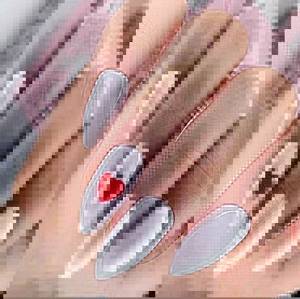
@nails_rokcsi

@anastasia_bekhter
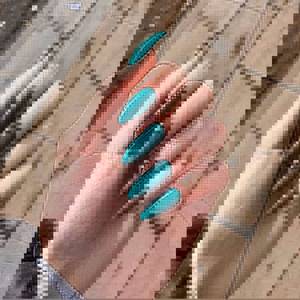
@chuunaills
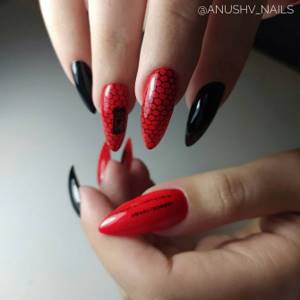
@anushv_nails
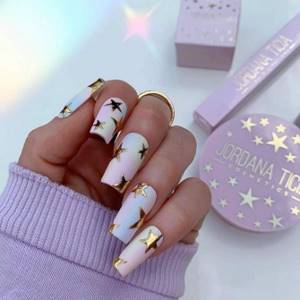
@nailstudio_laranovsk
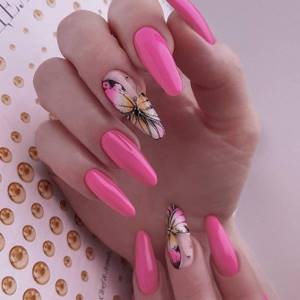
@ideas_____manicure

